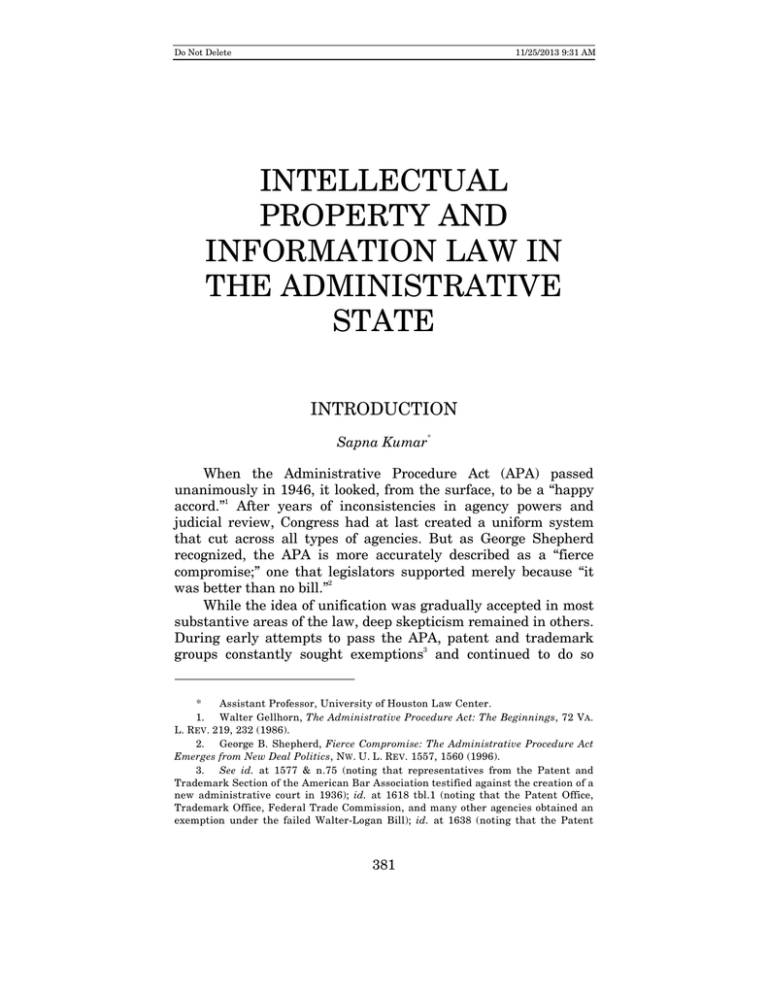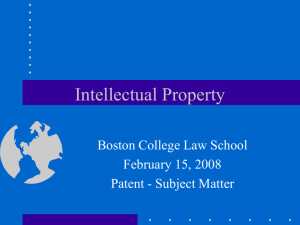INTELLECTUAL PROPERTY AND INFORMATION LAW IN THE ADMINISTRATIVE
advertisement

Do Not Delete 11/25/2013 9:31 AM INTELLECTUAL PROPERTY AND INFORMATION LAW IN THE ADMINISTRATIVE STATE INTRODUCTION Sapna Kumar* When the Administrative Procedure Act (APA) passed unanimously in 1946, it looked, from the surface, to be a “happy accord.”1 After years of inconsistencies in agency powers and judicial review, Congress had at last created a uniform system that cut across all types of agencies. But as George Shepherd recognized, the APA is more accurately described as a “fierce compromise;” one that legislators supported merely because “it was better than no bill.”2 While the idea of unification was gradually accepted in most substantive areas of the law, deep skepticism remained in others. During early attempts to pass the APA, patent and trademark 3 groups constantly sought exemptions and continued to do so * 1. Assistant Professor, University of Houston Law Center. Walter Gellhorn, The Administrative Procedure Act: The Beginnings, 72 VA. L. REV . 219, 232 (1986). 2. George B. Shepherd, Fierce Compromise: The Administrative Procedure Act Emerges from New Deal Politics, NW . U. L. REV. 1557, 1560 (1996). 3. See id. at 1577 & n.75 (noting that representatives from the Patent and Trademark Section of the American Bar Association testified against the creation of a new administrative court in 1936); id. at 1618 tbl.1 (noting that the Patent Office, Trademark Office, Federal Trade Commission, and many other agencies obtained an exemption under the failed Walter-Logan Bill); id. at 1638 (noting that the Patent 381 Do Not Delete 382 11/25/2013 9:31 AM HOUSTON LAW REVIEW [51:2 when unification became a forgone conclusion.4 Long after the APA’s passage, the U.S. Court of Appeals for the Federal Circuit resisted administrative law uniformity with regard to patents.5 Scholars continue to explore what the proper role of agencies is in intellectual property and information law. Although this conversation now has many voices,6 it began with only a handful of scholars who broke new ground in an uncharted area of law. The 2013 Houston Law Review Symposium Issue, Intellectual Property and Information Law in the Administrative State, brings five of these scholars together: Arti Rai, John Golden, John Duffy, Adam Candeub, and Christopher Yoo. This Issue is the result of an ongoing collaboration between the Review and the University of Houston Law Center’s Institute for Intellectual Property & Information Law (IPIL). Professor Arti Rai has focused on the intersection of patent law and administrative law for more than a decade, emphasizing what the patent system can learn from administrative law and how to promote innovation through agencies. Her current work for the Symposium, Improving (Software) Patent Quality Through the Administrative Process, examines how the PTO can use key provisions in § 112 of the Patent Act to shape the scope of software and other patents.7 Professor Rai further builds off of Professor Melissa Wasserman’s work, observing that the PTO may be able to obtain strong deference for its interpretations of the Patent Act under the Chevron doctrine.8 Professor John Golden’s patent research has explored issues of administrative law and federal courts. In Proliferating Patents Office was the only agency to seek an exemption under the failed McCarran-Sumners Bill). 4. See id. at 1638. 5. See In re Comiskey, 554 F.3d 967, 969, 971, 973–75 (Fed. Cir. 2009) (affirming the decision of the PTO on different grounds, notwithstanding Supreme Court precedent to the contrary); In re Zurko, 142 F.3d 1447, 1449–59 (Fed. Cir. 1998) (holding that the standards of review in the Administrative Procedure Act do not apply to patent decisions from the PTO), rev’d, Dickinson v. Zurko, 527 U.S. 150 (1999). 6. See, e.g., Kali N. Murray, The Cooperation of Many Minds: Domestic Patent Reform in a Heterogeneous Regime, 48 IDEA 289 (2008); Sarah Tran, Policy Tailors and the Patent Office, 46 U.C. DAVIS L. REV. 487 (2012); Melissa F. Wasserman, The Changing Guard of Patent Law: Chevron Deference for the PTO, 54 WM. & MARY L. REV. 1959 (2013); Ryan Vacca, Acting Like an Administrative Agency: The Federal Circuit En Banc, 76 MO. L. REV. 733 (2011); see also Sapna Kumar, The Accidental Agency?, 65 FLA. L. REV. 229 (2013). 7. Arti K. Rai, Improving (Software) Patent Quality Through the Administrative Process, 51 HOUS. L. REV. 503, 519–33 (2013). 8. Id. at 540–43 (discussing Chevron U.S.A. Inc. v. Natural Res. Def. Council, Inc., 467 U.S. 837 (1984)). Do Not Delete 2013] 11/25/2013 9:31 AM ADMINISTRATIVE STATE 383 and Patent Law’s “Cost Disease”, he examines the claim that the patent system is in crisis and argues that while the system is not as dire as some argue, it is under substantial strain.9 Professor Golden argues that the patent system must adapt, and he makes three key proposals for the PTO: (1) greater international work-sharing arrangements that might provide a relatively immediate, albeit perhaps only temporarily satisfactory, response to the internationalization of patent applications flowing into the USPTO; (2) greater privatization of functions of assessing patents’ or patent applications’ validity and proper scope; and (3) greater use of rulemaking or other means of ‘partially automating’ processes 10 of individual examination. Professor John Duffy has explored the intersection of public law and intellectual property for the past fifteen years. His Symposium article, The Inequities of Inequitable Conduct: A Case Study of Judicial Control of Administrative Process, examines patent law’s inequitable conduct doctrine, and he maintains that the most serious theoretical problem for the doctrine lies in the institutional relationship between the Federal Circuit and the PTO.11 Professor Duffy then examines how the doctrine can be reconciled with modern administrative law.12 Professor Adam Candeub is an expert in telecommunications and information law. In Transparency in the Administrative State, he proposes taking a broad view of what constitutes 13 transparency. Professor Candeub flips the idea of widespread government surveillance on its head, arguing for widespread surveillance of the government to allow for greater public 14 accountability. Professor Christopher Yoo has examined the regulation of information law for the past decade. His contribution to the Symposium, Is There a Role for Common Carriage in an Internet-Based World?, discusses the ongoing debate on whether 9. John M. Golden, Proliferating Patents and Patent Law’s “Cost Disease”, 51 HOUS. L. REV. 455, 476–83 (2013). 10. Id. at 460. 11. John F. Duffy, The Inequities of Inequitable Conduct: A Case Study of Judicial Control of Administrative Process, 51 HOUS. L. REV. 417, 420 (2013). 12. Id. at 450–54. 13. Adam Candeub, Transparency in the Administrative State, 51 HOUS. L. REV. 385, 386–90 (2013). 14. Id. at 411–16. Do Not Delete 384 11/25/2013 9:31 AM HOUSTON LAW REVIEW [51:2 common carriage is appropriate for the Internet.15 Professor Yoo synthesizes existing scholarship on the weaknesses of this type of regulation, and he further discusses its historical shortcomings. He concludes by advising caution in utilizing a common carrier approach to Internet regulation.16 Junior researchers like myself now stand upon the shoulders of these giants. It is therefore with great respect that I introduce the 2013 Symposium Issue of the Houston Law Review. 15. Christopher S. Yoo, Is There a Role for Common Carriage in an Internet-Based World?, 51 HOUS. L. REV. 545 (2013). 16. Id. at 608.


